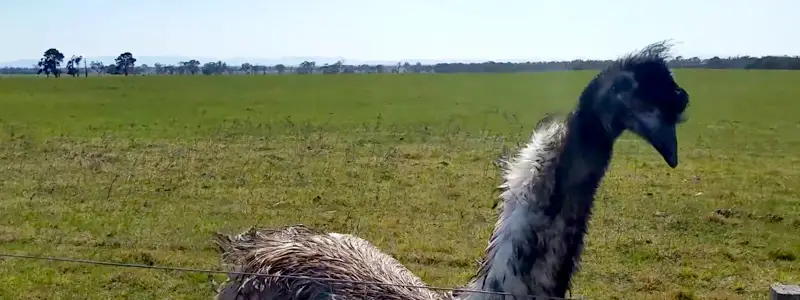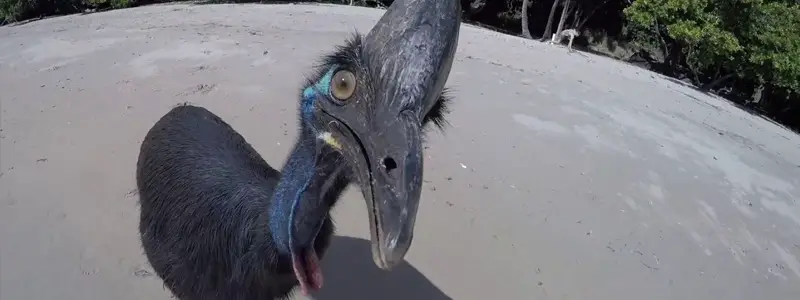Emu and cassowaries are the last remaining endemic large, flightless birds in Australia. Ostriches are also found here but are exotic, having been introduced for feather farming and having subsequently found their way into the wild.
Emus
Table of Contents
The Emu, Dromaius novaehollandiae, (fast-footed New Hollander) is the largest surviving native bird in Australia. It is found across almost all of mainland Australia but is rare in settled areas. It is mainly found in open woodland and plains. The ratite group, to which they belong, has been around for at least 80 million years.

Emu Physical description
Emus are large birds, the largest indigenous birds in Australia. They can stand up to 2m tall (6.5 feet) and can weigh up to 55Kg (120lb). They are predominantly brown in color with a white base to the feathers. This adaptation allows for convection cooling from the tips of the feathers, thus allowing foraging right through the hottest part of the day. The feathers are unique in that they have a double rachis emerging from a single shaft. Also, the feathers have non-interlocking barbs, something which is not necessary for flightless birds. The back of the neck is free from feathers and has a bluish tinge.
They have soft, broad beaks, designed for foraging, large eyes capable of seeing large distances, and powerful three-toed feet. They will walk almost constantly when awake (and not on the nest, of course) and can cover 10-25km per day.
Emus are strong swimmers and are happy to cool down by lying in a stream.
Emu Reproduction
Breeding takes place in the cooler months and is instigated by the male. He will build a rough nest in a shallow hollow and then begin mating with a female. They will continue to mate every day or two and every second or third day a single large, thick-shelled egg is laid This will continue until 9-12 eggs have been laid, although in a good season this number may reach 20. After the 5th or 6th egg has been laid the male will become broody and mating will cease. At this time the female will continue to mate with other males and will continue to lay eggs in the first nest.
For the next 8 weeks, the male will incubate the nest, never leaving to eat drink, or defecate and only standing to turn the eggs. During this time he will lose approximately a third of his body weight, surviving only on what dew and seeds can be reached from the nest.
Predation of the eggs is high, mainly from goannas (lace monitor lizards).
The hatchlings are around 25cm (10in) tall and are brown with cream-colored stripes. They are able to leave the nest after only two or three days. The male will stay with the chicks for at least six months. Without this attention, the chicks do not learn how to feed themselves. The chicks are fully grown at twelve months.
Ecology and Emu behavior
Emus are nomadic foragers, following the rains and feeding on grains, flowers, fruit, soft shoots, insects, grubs, and whatever else is available. They swallow stones to aid digestion. They are almost constantly walking and are able to trot for large distances or sprint for shorter distances at up to 50kph. They require water daily.
Emus and man
The number of emus in the wild has grown significantly since the arrival of European settlers due to improved pasture and the availability of water from dams. They have regularly been viewed by the farming community as pests.
Since 1994 all Australian states have been permitted to raise emus. They are farmed for their meat, their oil, and their leather. However, the industry has not grown in the manner many expected and many farms and slaughterhouses have closed.
Cassowary
Three species of cassowary are still in existence, one of which, the Southern Cassowary (casaurias casaurias), is found in Australia’s far north in the tropical forests of Queensland. It is classified as vulnerable due to habitat loss.

Cassowary Physical description
Cassowaries are large flightless ratites and at 1.8m (5 1/2 feet) tall are amongst the largest birds on earth. They can weigh a maximum of 60kg (130lb), have drooping black plumage with brightly colored blue necks, and have bright red wattles. They have a bony casque, or helmet, on top of the head (purpose uncertain, although it has been observed using it for pushing aside forest littler looking for food) making them the only armored birds in the world. They are also known for the sharp claws on their three-toed feet, with which they have been known to kill an enemy (including man) with a single, disemboweling kick. They can run at up to 50kph, can jump 1.5m from a standing position, and are capable swimmers. Females are marginally bigger than males. Life span 40-50 years.
Cassowary Reproduction
Cassowary reproduction is very similar to that of the emu, to whom they are closely related. Individuals tend to live solitary lives but come together in the breeding season. Males will stake territory and will build a nest. He will mate with the female and she will lay 3-5 eggs. Thereafter she will mate with other males whilst he tends the nest and then the chicks. He will remain with the chicks for at least the first 9 months. The eggs are incubated for two months. The chicks are brown with cream-colored stripes.
Ecology and Cassowary behavior
Cassowaries live in forests where they forage for fruit from the ground. They will also eat fungi and small animals.
Cassowaries and man
Cassowaries are known as the most dangerous birds on Earth. Despite this tag, there are relatively few documented cases of attacks on man, although these attacks can easily be fatal. Cassowaries are very shy birds and will almost always run away from contact with humans (making them very difficult to study). Attacks are most common when provocation is involved or when a male is protecting the nest or young.
Cassowaries have been traded for feathers and food for possibly 500 years, mainly in Papua New Guinea.
The destruction of the rainforest, their natural environment, is the major threat to their survival since they require large expanses of unbroken forests to adequately survive. They are also threatened by the hunting trade and by cars.
Habitat loss has caused some birds to venture out of the forest looking for food. This has caused conflict with fruit growers.
Main sources for this information:
http://animaldiversity.ummz.umich.edu/
wikipedia
Birds of Australia, Slater et al.
http://www.oaklandzoo.org
